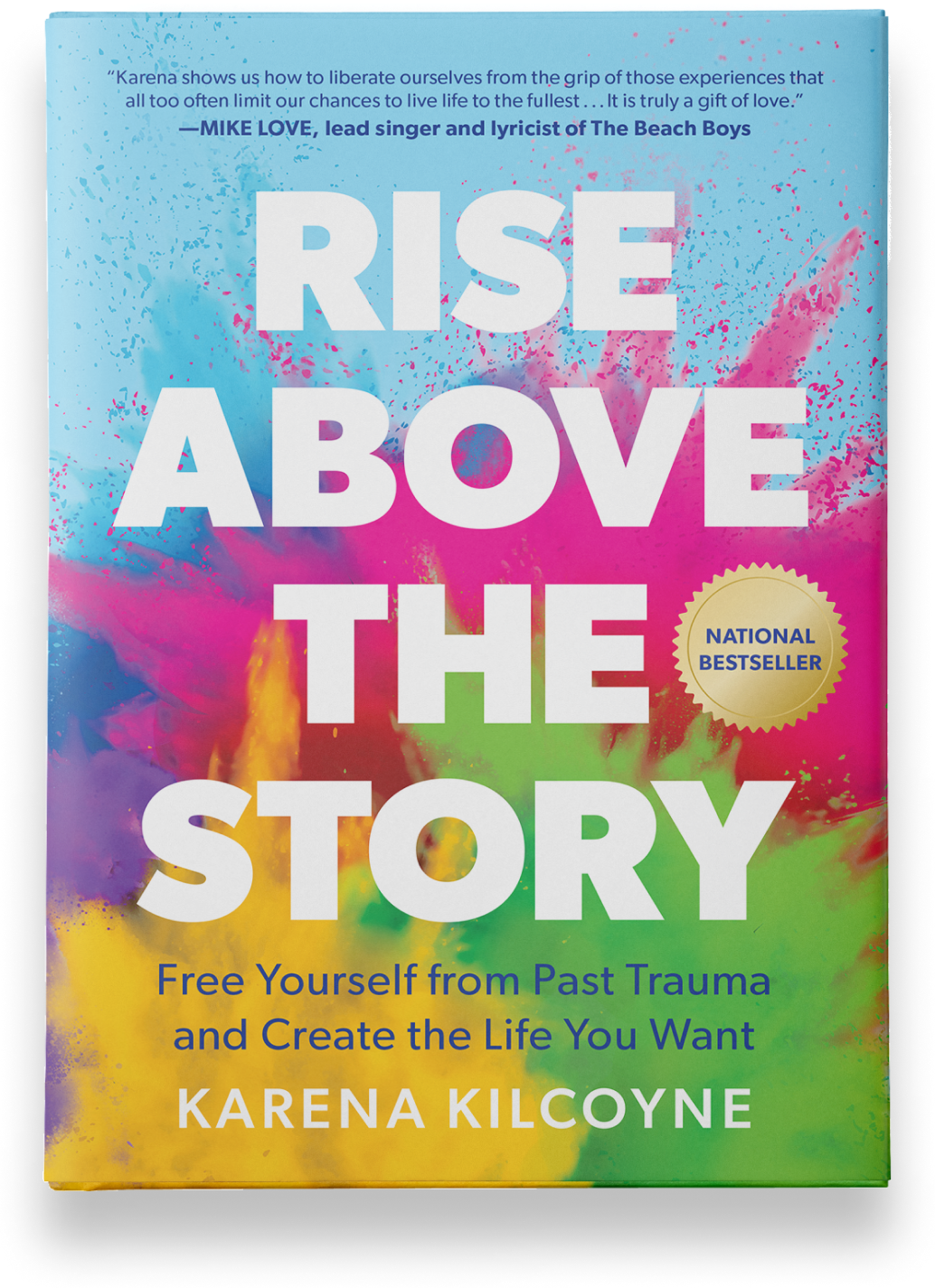Feb 7, 2022

Get your FREE Rise Above the Story Acknowledgement Guide.
Sign up for my newsletter and get your FREE guide to start your journey of self-love and transformation today.

Feb 7, 2022
After months of surveilling our house, the F.B.I. got a warrant for Dad’s arrest. Perhaps Dad knew, which is why he left town a day before they showed up looking for him. When the feds realized Dad had skipped town, they splashed his photo across the local news, along with heavy words like “wanted” and “at large.” Even though I was only eleven years old, I wondered if all this was overkill for a guy wanted for falsifying some car titles.
Dad normally drove me to my Christian school, but with him on the lam, Mom took me to school the next day. As I walked toward the classroom, students buzzed about, laughing and talking. I was relieved to be there with my friends and not stuck at home worried about Dad.
When I got to the classroom doorway, the chatter stopped and everyone stared at me.
“Come on in. Hurry, hurry. Let’s get started,” the teacher said, waving me in her direction.
I slinked to my desk, diverting my gaze. I caught my friend Jaime’s eye and half-smiled at her. She wrinkled her nose just like she did when her mom packed her fruit instead of cookies in her lunch box. Did they all see Dad on TV? Did they know he was a fugitive? I slid down in my chair, my face red with humiliation.
The teacher led us in prayer and then with excitement in her voice, she began the morning announcements.
“As you know, our class graduation is coming up. I’ve had a chance to look over all the test papers again and we have a new list of top students for graduation,” she said, shuffling papers on the podium.
I sat up, bewildered because just a few days before, the teacher had announced that I was the valedictorian. What was this “new” list about?
She read the names off the list and when mine wasn’t first, my ears buzzed. I didn’t hear when the teacher called my name, but Jamie later told me I was third.
When Mom picked me up that afternoon, I got in the car and slammed the door.
“What’s wrong?” she asked.
“I’m not the valedictorian anymore,” I said, angry tears filling my eyes.
“What? Why not?”
“I don’t know. They didn’t say.”
Mom threw the car in park right there in the middle of the pick-up line and slammed her door harder than I had slammed mine.
“Let’s go,” she yelled, storming toward the school entrance.
People honked their car horns and drove around us, but Mom didn’t care. She grabbed my hand and marched into the school, straight down the hallway, and into the principal’s office. She stood in front of Mr. Hardwick’s desk, shoeless, but wearing her favorite socks, bright pink fold-overs with red hearts. Sunglasses pushing back her wild, wavy hair and socks blaring, she looked ridiculous.
“How is it that my daughter is no longer the valedictorian?” she asked.
He leaned back in his chair. His robust belly framing a tie clip adorned with a gold mini Jesus hanging on a cross. “Well, her teacher looked over the final exams again and two other students scored higher than your daughter.”
“Bullshit. I know exactly what this is about,” said Mom. “Don’t sit there and lie to me.”
“I’m sorry for what your family is going through, but she will not be the valedictorian.” He folded his hands matter-of-factly on the desk.
Right then, in Mr. Hardwick’s office, I wrote the story of my worthlessness. I had experienced worthlessness and shame in flashes before that moment, but I hadn’t yet experienced it about something I had worked so hard for. Nor had I experienced losing friends because of something Dad did, something that was completely out of my control.
That was the beginning of a long journey and a deep story of shame, abandonment, and worthlessness that I wove for myself.
Over the years, the web of my false story became so thick and gnarled that it bound me in a false reality. I routinely chose less even though I wanted more. I made safe decisions or no decisions at all, allowing the tide of life to dictate my direction. This went on for years, until the pain of it all became too much. The real me, as if she were drowning, screamed and flailed. I knew I had to save myself, to rise above my story, or undoubtedly all the old pain, the stuffed emotions would kill me.
The first step in rising above your story…
If you’ve been with me on this Rise Above the Story journey so far, you know that the first step in rising above is acknowledging your story––being honest about the story you’ve written for yourself. Rising above can’t happen, it won’t happen, if we don’t first identify the story that’s holding us back.
The next step…
Once we’ve done that, once that story is out in the open, we have to untangle it––we must figure out how we got caught up in the false narrative. This is a crucial step in not only in healing ourselves from this story but it also teaches us how to avoid getting tangled up in future stories.
For many of us we get spun up in our stories early in life. This can manifest itself in many ways, including how:
Our false stories gain even more power through our continued validation of the story. It’s a vicious cycle. We write the story of abandonment, worthlessness, and shame, and then we view the world and what happens to us through that broken lens. Time after time, with each loss or setback, we see more abandonment, worthlessness, and shame until it becomes automatic. We come to expect it. We may even find comfort in it, as strange as that may sound.
For some of us, the entanglement may even morph into victimhood, where we continually settle for less and use our “loss” as a way to get the attention and “love” we so desperately crave.
So how do we untangle ourselves from the childhood stories of abandonment, worthlessness, and shame?
We Deconstruct the Story Piece by Piece…
Spend some time journaling and asking yourself specific questions that will lead to untangling the story. Imagine a rope with a bunch of knots and that it’s your job to untangle it. The rope is heavy and long. It’s wrapped around you. Untangling each knot will take time and patience. It will take all your focus to see where the rope leads and how its entwined with itself. Here are a few questions that will get you started:
Talk to You Inner Child…
I know. This one might feel strange, uncomfortable even. But I want you to do it anyway. This is such an amazingly powerful way to untangle our oldest stories. I did this often during my healing journey as so much of my pain and many of my stories originated in childhood.
Close your eyes and take ten deep breaths. Imagine yourself somewhere where you feel safe, light, and happy. A beach. The mountains. In front of a fire. In a kayak. Now sit in that space for as long as you need until you feel relaxed and comfortable. When it feels right, ask your inner child, that little you, to join you.
They may not show up right away. This might be the part of you traumatized by abandonment. The part of you that doesn’t trust. This may be the hardest part of the entire exercise––the willingness to show up and participate in the untangling. For so many of us, the risk of dredging up old pain feels unbearable. We may turn away, or as I did so many times, continue to stuff and avoid the emotions. But I’m here to tell you that you can’t do that forever. You can’t hide, run, or avoid the truth of who you are and who you’re meant to be.
Once your inner child shows up (and they will), sit together for a bit. How does she or he look? Do you remember that sweet, innocent part of you that didn’t deserve to be hurt and abandoned? The part of you that loved to laugh and play and run?
Feeling that connection, it’s time to talk to your inner child. Here are a few ways to get started:
In my own journey, inner child work was one of the most valuable parts of my healing. I also saw a therapist and wrote letters to my inner child. I did what I needed to do to untangle my story and bring the pain of my abandonment, worthlessness, and shame to the surface.
While your story may not be the same as mine, we all carry the burden of false stories that keep us tangled up in the past. In the beautiful journey of becoming our truest self, we must break from those limiting narratives if we are ever to rise above.
Related Posts

Get your FREE Rise Above the Story Acknowledgement Guide.
Sign up for my newsletter and get your FREE guide to start your journey of self-love and transformation today.

NEW
RELEASE
ORDER YOUR COPY
Available where books are sold